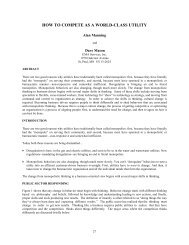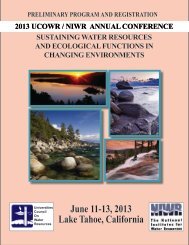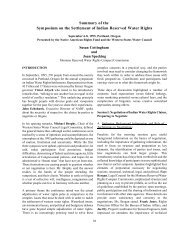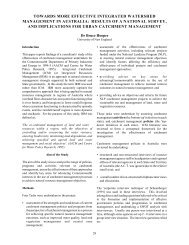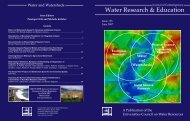Full Journal of Contemporary Water Research and Education, Issue ...
Full Journal of Contemporary Water Research and Education, Issue ...
Full Journal of Contemporary Water Research and Education, Issue ...
Create successful ePaper yourself
Turn your PDF publications into a flip-book with our unique Google optimized e-Paper software.
Trajectories in Australian <strong>Water</strong> Policy45environmental discourse on “sustainable development.”One <strong>of</strong> the key recommendations <strong>of</strong> the “WentworthGroup” in the formulation <strong>of</strong> the National<strong>Water</strong> Initiative was that the role <strong>of</strong> regional, catchment-based institutions should be consolidated as thepreferred approach to natural resource management:Management must be local, because social<strong>and</strong> environmental conditions vary <strong>and</strong> statelevel structures are not sufficiently connectedto the farmers <strong>and</strong> irrigators who mustimplement the strategy through their actions.Distant authorities do not have access to thelocal knowledge required to develop <strong>and</strong>deliver innovative strategies (TWG 2003).The decentralization <strong>of</strong> government policy <strong>and</strong>its implementation is not a new idea (Hutchcr<strong>of</strong>t2001) <strong>and</strong> it has been widely promoted as amechanism to promote democratic <strong>and</strong> developmentobjectives. The National <strong>Water</strong> Initiative’semphasis on participatory approaches to resourcemanagement, at the catchment <strong>and</strong> local scalesthrough programs such as L<strong>and</strong>care, reflects theshared problem-solving approach encapsulatedin the “democratic pragmatism” discourse.A further theme in the National <strong>Water</strong> Initiative,<strong>and</strong> indeed in Australian natural resourcemanagement policies more broadly, is the potentialrole <strong>of</strong> “stewardship.” While not made explicitin the National <strong>Water</strong> Initiative, the appointment<strong>of</strong> environmental water managers to achieveenvironmental <strong>and</strong> other public benefit outcomes([78(ii)]), together with recent scholarship on thesubject within policy circles 10 reflects the notionclosely. There has also been increasing debateabout the potential role <strong>of</strong> indigenous Australiansto act as environmental stewards in return forfinancial compensation (Altman 2006). Theseideas insert the discourse <strong>of</strong> “green radicalism”into the National <strong>Water</strong> Initiative agenda.The objectives <strong>of</strong> the National <strong>Water</strong> Initiative,<strong>and</strong> the choice <strong>of</strong> policy instruments to achievethem reflect the divergent influences <strong>of</strong> various,<strong>of</strong>ten competing ideas that have evolved overmany years <strong>and</strong> now culminate in contemporarywater policy. The two key imperatives <strong>of</strong>environmental sustainability <strong>and</strong> economicrationalism have been enshrined in the National<strong>Water</strong> Initiative, but as we saw in the previoussection, the inability to reconcile many <strong>of</strong> theconflicting rationalities between them has resultedin significant challenges for the successfulimplementation <strong>of</strong> the National <strong>Water</strong> Initiative.The difficulties <strong>of</strong> implementation have beenrecognized through a research agenda developedby leading policy <strong>and</strong> research <strong>and</strong> developmentfigures (L<strong>and</strong> <strong>and</strong> <strong>Water</strong> Australia 2005).Comparative Perspectives: <strong>Water</strong> Policy inthe European Union <strong>and</strong> the United StatesThe European Union, United States <strong>and</strong>Australia share a number <strong>of</strong> challenges in waterresource management: all are characterized bymulti-jurisdictional <strong>and</strong> multi-level governancestructures with <strong>of</strong>ten significant fragmentation;all rely on shared water resources between statesfor agricultural <strong>and</strong> industrial production; <strong>and</strong>all have influential agricultural interests thatinevitably advocate strongly for that sector inpolicy formulation. In this section, we brieflyexamine the contrasts <strong>and</strong> similarities between theEuropean Union <strong>and</strong> United States water policy,in relation to Australia’s National <strong>Water</strong> Initiative.In September 2000, after a decade <strong>of</strong> politicalstruggle, the European Union adopted a newframework for Europe’s water legislation,known as the <strong>Water</strong> Framework Directive. Whenthe European Commission formally drafted aproposal for the <strong>Water</strong> Framework Directivein February 1997, the then European UnionEnvironment Commissioner hailed it as a triumph:This important proposal is on the cutting edge<strong>of</strong> environmental protection. All water usesnecessary to life <strong>and</strong> society—from drinkingto bathing to agriculture to industry—will becarried out with a respect that ensures that wateris fit <strong>and</strong> sustainable into the next century… 11Like the National <strong>Water</strong> Initiative, the <strong>Water</strong>Framework Directive represents a major advancein water policy with three concepts included inEuropean water legislation for the first time:the need to protect <strong>and</strong> improve the aquaticenvironment <strong>and</strong> its ecosystems (Article 1); theorganization <strong>and</strong> regulation <strong>of</strong> water managementat the level <strong>of</strong> river basins (Article 3); <strong>and</strong> thatwater pricing should be determined on thebasis <strong>of</strong> full cost recovery (Article 9). The mainelements <strong>of</strong> the <strong>Water</strong> Framework Directive are:1. an ecological <strong>and</strong> holistic water statusJOURNAL OF CONTEMPORARY WATER RESEARCH & EDUCATIONUCOWR



